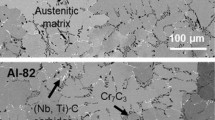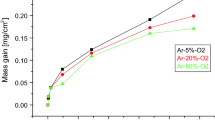Abstract
It is established that microalloying of γ-titanium aluminides with scandium provides an increase in heat resistance, structure refinement and modification, and formation of a dispersion-strengthened structure with a coherent bond between the strengthening and matrix phases. Proceeding from this an improvement might be expected in strength characteristics over a wide temperature range. The effect in scandium consists in changing the ratio of Al:Ti thermodynamic activities in the direction of forming aluminum oxide at the alloy surface during oxidation as a result of the deoxidizing effect of scandium and the formation of fine oxide inclusions. As a result of this aluminum does not form oxides within the alloy. The distribution of elements within the microstructure of γ-Ti ― Al with 5%Cr after oxidation at 900°C for 300 h is studied. It is established that the surface scale layer that forms sometimes contains Cr in addition to Al and O. A diffusion mechanism is suggested for realizing the Cr-effect according to which chromium and aluminum ions participate in place of titanium ions in forming Al2O3 ― Cr2O3 scale at the metal ― air atmosphere interface.
Similar content being viewed by others
REFERENCES
D. M. Dimiduk, Mat. Sci. and Eng., A263, 281-288 (1999).
F. H. Froes, C. Surynarayana, and D. Eleizer, “Potential of intermetallics to replace superalloys for advanced operation conditions in gas turbines,” J. Mater. Sci., 27, 5133-5140 (1992).
W. Smarsly and L. Singheiser, “Synthesis properties and application of titanium aluminides,” in: Materials for Advanced Power Engineering, Part 2, D. Coutsouradis et al. (eds.), Kluwer Academic Publishers, New York (1994), pp. 1731-1756.
M. Eckert and H. Hilpert, Materials and Corrosion, 48, No. 10/11, 10 (1997).
G. H. Meier et al., Oxidation of High-Temperature International, T. Grobstein and J. Doychak (eds.), PA: TMS, Warrendale (1988).
M. P. Brady, J. L. Smialek, D. L. Humphrey, and J. Smith, Acta. Mater., 45, No. 6, 2371 (1997).
G. V. Samsonov, T. G. Bulankova, A. L. Burykina, et al., Physicochemical Properties of Oxides: Handbook [in Russian], Metallurgizdat, Moscow (1969).
F. Dettenwanger et al., Mater. Res. Soc. Symp., 364, 98 (1995).
G. V. Samsonov and I. M. Vinitskii, Refractory Compounds [in Russian], Metallurgiya, Moscow (1976).
V. A. Lebedev, V. I. Kober, and L. F. Yamshchikov, Thermochemistry of Alloys of Rare-Earth and Actinoid Elements: Handbook [in Russian], Metallurgiya, Chelyabinsk (1989).
K. Taylor and M. Derby, Physics of Rare-Earth Compounds [Russian translation], Mir, Moscow (1974).
R. Wagner, F. Appel, B. Dogan, et al., “Investment casting of TiAl based alloys: Microstructure and data base for gas turbine applications,” in: Materials for Advanced Power Engineering, Part 2, D. Coutsouradis et al. (eds.), Kluwer Academic Publishers, New York (1994).
Y-W. Kim, Mater. Sci. and Eng., A192/193, 519 (1995).
M. Es-Souni, A. Bartels, and R. Wagner, Mater. Sci. Eng., A192/193, 698 (1995).
K. I. Portnoi and N. I. Timofeeva, Oxygen Compounds of Rare-Earth Elements: Handbook [in Russian], Metallurgiya, Moscow (1986).
M. P. Brady, W. J. Brindley, J. L. Smialek, and I. E. Lossi, JOM, November, 46-50 (1996).
L. N. Larikov and V. I. Isaichev, Structure and Properties of Metals and Alloys: Handbook [in Russian], Nauka Dumka, Kiev (1987).
E. M. Sokolovskaya and L. S. Guzei, Metal Chemistry [in Russian], Izd. Mosk. Univ., Moscow (1986).
N. A. Toropov et al., Composition Diagrams for Refractory Oxide Systems: Handbook, Part 1, Binary Systems [in Russian], Nauka, Leningrad (1985).
O. Kubashevsky and B. Hopkins, Oxidation of Metals and Alloys: 2nd ed. [Russian translation], Metallurgiya, Moscow (1965).
J. Benar (ed.), Oxidation of Metals, Vol. 2 [Russian translation], Metallurgiya, Moscow (1969).
Author information
Authors and Affiliations
Rights and permissions
About this article
Cite this article
Oliker, V.E., Trefilov, V.I. Effect of Scandium and Chromium on the Structure and Heat Resistance of Alloys Based on γ-TiAl. Powder Metallurgy and Metal Ceramics 39, 487–497 (2000). https://doi.org/10.1023/A:1011374724719
Issue Date:
DOI: https://doi.org/10.1023/A:1011374724719




